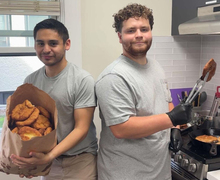Students face difficulties with absentee ballot voting process
Emily Steinberger | Photo Editor
Many states have made changes to expand absentee voting eligibility in response to the risk COVID-19 poses to voting in person, but policies vary by state.
The Daily Orange is a nonprofit newsroom that receives no funding from Syracuse University. Consider donating today to support our mission.
Syracuse University senior Isabel Tabs hasn’t received her absentee ballot in time to vote.
Tabs, a broadcast and digital journalism major, applied for an absentee ballot in September to vote in her hometown in Essex County, New Jersey. But by October, Tabs still hadn’t received her ballot.
“I called my county board of elections, my representative. I even went to call my current state senator and my representative for my county,” Tabs said.
She isn’t alone. Several SU students said they’ve experienced difficulty with the absentee voting process, and they’re worried about whether their ballots will arrive in time or if they filled them out correctly.
Tabs made calls every day, but it was difficult to get in contact with anyone who could help her. Some of her friends also had a hard time getting their absentee ballots from Essex County, which includes the city of Newark, she said.
“You wouldn’t think trying to register to vote and being registered and trying to mail in your ballot would be so complicated, but it is,” said Zoë Selesi, a junior magazine journalism major.
Many states have made changes to expand absentee voting eligibility in response to the risk COVID-19 poses to voting in person, but policies vary by state.
Colorado, Hawaii, Oregon, Utah and Washington conducted their elections entirely by mail prior to the pandemic. These states automatically mailed ballots directly to all voters this year. California, New Jersey, Nevada, Vermont and Washington, D.C., have switched to directly mailing ballots to all registered voters for this election.
Changes in other states include either sending absentee ballot applications to all voters and allowing no-excuse absentee voting. New York allowed voters this year to cite concerns about COVID-19 as an excuse to vote absentee.
Selesi, who is also from California, had a difficult time registering to vote and figuring out where to send her ballot.
Selesi thought she registered to vote on campus during her freshman year when student volunteers from New York Public Interest Research Group encouraged her to do so. But when she went to check her registration status to prepare for the 2020 election, she found she actually wasn’t registered.
“I remember getting something in the mail that basically said I’m registered to vote and I can go out and vote in the local election, so when it came to the presidential election, I was like let me just check my voter registration status,” Selesi said. “Lo and behold, I wasn’t registered.”
In mid-October, Selesi was able to register to vote in California and she received her ballot on Oct. 28 – less than a week from Election Day. She found herself unsure of where to submit her ballot. On social media, she kept seeing posts saying not to send her ballot through the mail because of potential delays and instead drop her ballot off at a drop box or vote in person.
A surge in mail-in voting this year could overwhelm the United States Postal Service, which has struggled with a shortage of funding ahead of the 2020 election. Experts have said delays in post offices could result in ballots not being mailed out or arriving on time.
Under California’s policies for mail-in voting, as long as Selesi’s ballot is postmarked before or on Nov. 3, the county elections office will still receive and count her vote.
“I’m just kind of worried because this is my first time ever voting,” Selesi said. “It’s also the presidential election – super important.”
Tabs still hasn’t received her ballot. If she didn’t have a prior commitment on Election Day, she would’ve found a way to get home to vote, she said.
“Now, it’s Nov. 2, the day before the election and I hadn’t voted and I can’t vote, and this is my first presidential election I’m eligible to vote for,” Tabs said. “It’s really just discouraging.”
Published on November 2, 2020 at 9:18 pm
Contact Madison: mntyler@syr.edu






